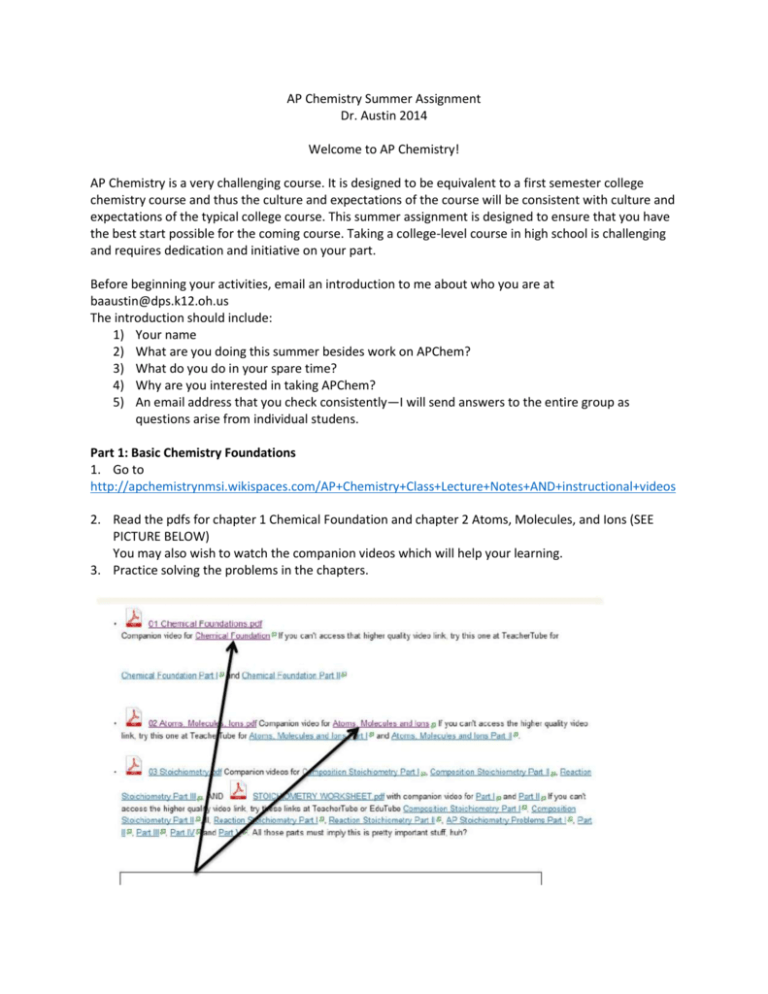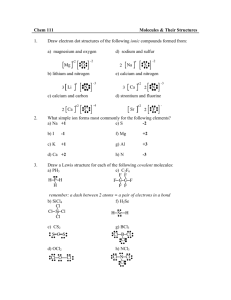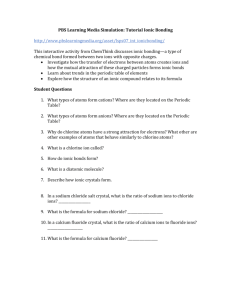Print-out of ALL work completed on quizlet is due July 11, 2014
advertisement

AP Chemistry Summer Assignment Dr. Austin 2014 Welcome to AP Chemistry! AP Chemistry is a very challenging course. It is designed to be equivalent to a first semester college chemistry course and thus the culture and expectations of the course will be consistent with culture and expectations of the typical college course. This summer assignment is designed to ensure that you have the best start possible for the coming course. Taking a college-level course in high school is challenging and requires dedication and initiative on your part. Before beginning your activities, email an introduction to me about who you are at baaustin@dps.k12.oh.us The introduction should include: 1) Your name 2) What are you doing this summer besides work on APChem? 3) What do you do in your spare time? 4) Why are you interested in taking APChem? 5) An email address that you check consistently—I will send answers to the entire group as questions arise from individual studens. Part 1: Basic Chemistry Foundations 1. Go to http://apchemistrynmsi.wikispaces.com/AP+Chemistry+Class+Lecture+Notes+AND+instructional+videos 2. Read the pdfs for chapter 1 Chemical Foundation and chapter 2 Atoms, Molecules, and Ions (SEE PICTURE BELOW) You may also wish to watch the companion videos which will help your learning. 3. Practice solving the problems in the chapters. Part 2: Memorize 30 polyatomic ions (30 points) 1. Go to quizlet.com 2. If you do not have one already, set-up an account 3. Enroll in the AP Chem class at Stivers by going to this link: http://quizlet.com/join/SzaTRJ39F 4. Review the four flashcard sets: Polyatomic Ions—Names & Formulas Polyatomic Ions—Names & Charges (make sure that ‘see English first’ is checked for activities) Polyatomic Ions II—Names & Formulas Polyatomic Ions II—Names & Charges (make sure that ‘see English first’ is checked for activities) 5. Complete ‘learn’ ‘scatter’ ‘space race’ and ‘test’ activities for all four flashcard sets 6. Using the print feature on the browser icon (top left), print out a sheet that shows what you have completed all four activities for all four flashcard sets 7. Be prepared for a quiz on the polyatomic ions on the first day of class August, 2012 Print-out of ALL work completed on quizlet is due July 11, 2014 Part 3: Complete the following problem set (100 points) You should work alone. You should not collaborate with any other students on completing this set. You may use textbooks or internet resources to complete Resources: Any basic chemistry text http://www.collegeboard.com/ap/students/chemistry/index.html Quizzes (multiple choice and free response) http://www.adriandingleschemistrypages.com/apquiz.html Respond to the following prompts on a separate sheet of paper (or sheets of paper) NOTE: When numbers represent a physical quantity, the number MUST have a unit label in order to receive points. No label = no points. NO EXCEPTIONS! SHOW ALL WORK 1. What are the most common guidelines for determining number of significant figures? 2. Pick a number with more than 3 digits. Use the guidelines from 1 to determine the number of significant figures. Write all of your logic for how you came to the answer. 3. Use unit analysis or factor labeling to convert the following (remember: SHOW ALL WORK): a. 515 m = ____ miles f. 10 kilometers = ___ m b. 200 in = ____ meters g. 15,060 milligrams = ____ grams c. 325 days = ____ seconds h. 3,264 milliliters = ____ liters d. 20 gallons = ____ mL i. 9,674,444 grams = ___ e. 3 meters = ___ cm kilograms 4. Identify each of the following as units of mass, volume, length, density, energy or pressure. a. mg d. mm g. atm b. mL e. kg/m3 h. cal 3 c. cm f. kJ 5. Most laboratory experiments are performed at room temperature or 25°C. Express this temperature as a. °F b. K 6. How many significant figures are in each of the following? a. 1.92 mm d. 460.00 L b. 0.030100 kJ e. 0.00036 cm3 23 c. 6.022 x10 f. 100 atoms g. 1001 h. 0.001 i. 0.0101 7. Rewrite the following in correct scientific notation: a. 350,000,000 cal b. 0.0000721 mol c. 0.0000000809 Å d. 765,400,000,000 atoms 8. Calculate the following and record the answer with the correct number of significant figures. a. b. c. d. e. f. g. 1.27 𝑔 5.296 𝑐𝑚3 12.235 𝑔 1.01 𝐿 12.2 g + 0.038 g 17.3 g + 2.785 g 2.1 x 3.21 200.1 x 120 17.6 + 2.838 + 2.3 + 110.77 9. Give the chemical symbols for the following elements: a. Carbon c. Titanium b. Sulfur d. Nitrogen 10. Write the Latin and Common names for each of the element’s symbols: a. Na d. Sn b. Au e. Fe c. Ag f. Hg e. Helium g. K 11. A solid white substance A is heated strongly in the absence of air. It decomposes to form a new white substance B and a gas C. The gas has exactly the same properties as the product obtained when carbon is burned in and excess of oxygen. Based on these observations, can we determine whether solids A and B and the gas C are elements or compounds? Explain your conclusions for each substance. 12. Identify each of the following as either a physical process or a chemical process: a. Corrosion of aluminum metal e. Explosion of nitroglycerin b. Melting of ice f. Milk turning sour c. Pulverizing an aspirin g. Burning of paper d. Digesting a candy bar h. Forming of frost on a cold night i. Bleaching of hair with hydrogen peroxide j. Hammering a copper wire flat 13. Calculate the mass of O2 produced if 2.50 g of KClO3 are completely decomposed by heating. 14. Write the formula of the following compounds—Points only given if you show your logic by using the ‘criss-cross’ method for charge a. Calcium sulfate d. Potassium perchlorate b. Ammonium phosphate e. Barium oxide c. Lithium nitrite f. Zinc sulfide 15. Convert 3.57 atm to (use unit analysis or factor-labeling method) a. mm Hg b. pascals 16. Define the words and give an example of each: atomic number, mass number, molecular formula, structural formula, empirical formula, isotopes, cation, anion, metalloid, allotrope, stoichiometry. 17. White gold is an alloy that typically contains 60.0% by mass gold and the remainder is platinum. If 174 g of gold are available, how many grams of platinum are required to combine with the gold to form this alloy? 18. What is the empirical formula of a compound that contains 53.73% Fe and 46.27% of S? 19. Determine the number of molecules in 2.23 mol of nitrogen (N2) molecules. 20. Identify the following as a diatomic molecule, molecular compound, ionic compound, atomic element (more than one label may apply): a. F2 e. KF i. Rust (Fe2O3) b. Cl2 f. CO2 j. MgO c. C g. H2 k. O2 d. NaCl h. Ag l. I2 21. What is the difference between a. A chlorine atom and a chloride ion? b. A sodium atom and a sodium ion? 22. How many grams of nitrogen are present in 2.3 moles of nitrogen gas? 23. Calculate the mass in grams of each of the following: a. 6.02x1023 atoms of Mg b. 3.01 x 1023 formula units of CaCl2 24. How do you distinguish: a. An element from a compound b. An element from a mixture c. A true solution from a heterogeneous mixture d. Distillation from filtration 25. An extensive property is one that depends on the amount of the sample. Which of the following properties are extensive? a. Volume d. Energy b. Density e. Melting point c. Temperature 26. Define and give examples of: a. Acid b. Base c. Salt 27. What mass of copper is required to replace silver from 4.00 g of silver nitrate dissolved in water? Cu(s) + AgNO3 Cu(NO3)2 + Ag 28. Write the chemical formulas for the following compounds: a. Calcium carbonate b. Ammonium phosphate c. Sodium chloride d. Sodium oxide e. f. g. h. Calcium sulfate Zinc (II) nitrate Iron (III) phosphate Nickel (II) fluoride 29. Define in your own words (words a high school student would use): a. Law of conservation of mass b. Law of multiple proportions 30. An isotope of iodine is used in thyroid disorders is 131 53𝐼 . How many: a. Protons are in its nucleus b. Neutrons are in its nucleus c. Electrons are in the atom d. Neutrons and protons are in the 𝐼 − ion formed from this isotope? 31. Mercury has an atomic mass of 200.59 amu. Calculate the a. Mass of 3.0 x 1010 atoms b. Number of atoms in one nanogram of mercury. 32. Calculate the molar masses of: a. Ammonia (NH3) b. Baking soda (NaHCO3) c. Osmium metal (Os) 33. Convert the following to moles: a. 3.86 g of carbon dioxide b. 6.0 x 105 g of hydrazine (N2H4), a rocket propellant 34. The molecular formula of morphine, a pain-killing narcotic, is C17H19NO3. a. What is the molar mass? b. What fraction of atoms in morphine is accounted for by carbon? c. Which element contributes least to the molar mass? 35. Calculate the percent by mass of the following compounds: a. SO3 b. CH3COOCH3 c. Ammonium nitrate 36. Determine the empirical formula of the compounds with the following compositions by mass: a. 10.4% C, 27.8% S, and 61.7% Cl b. 21.7% C, 9.6% O, and 68.%F 37. Write a balanced reaction for the following: a. Reaction of boron trifluoride gas with water to give liquid hydrogen fluoride and solid boric acid (H3BO3). b. Reaction of magnesium oxide with iron to form iron (III) oxide and magnesium. c. The decomposition of dinitrogen oxide gas to its elements. d. The reaction of calcium carbide solid with water to form calcium hydroxide and acetylene (C2H2). e. The reaction of solid calcium cyanide Ca(CN)2 with water to form calcium carbonate and ammonium gas. f. Nitrogen gas reacting with hydrogen to form ammonia. g. Sodium oxide reacting with water to form sodium hydroxide and hydrogen. h. Magnesium and nitrogen gas reacting to form magnesium nitride. 38. Define molarity, molality, mole-fraction, and mass percent of a solution. In your definition, distinguish similarities and differences. 39. How many grams of solute are present in 50.0 mL of a 0.360 M solution of sodium chloride? Completed Problem Set is due July 11, 2014 COMPLETING THE QUIZLET SETS AND PROBLEMS SETS ARE REQUIRED; IF YOU DO NOT COMPLETE THESE ASSIGNMENTS, YOU MUST CONTACT MR. ASADORIAN BY JULY 12, 2014 TO DROP THE COURSE. See me if you have any questions. If you need to contact me over the summer, email me at baaustin@dps.k12.oh.us or call me at 342-0050. Have a great summer!






